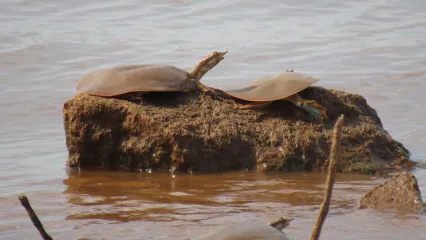
Description
The razor-backed turtle is one of several aquatic turtles native to southeastern Oklahoma. The shells are light brown to orange in color with dark, gray streaks that have the potential to fade throughout the passage of time. Their varying colored skin of brown, pink, and gray consists of numerous small black dots that sprinkle across the body. They have a high-domed top shell, or carapace, with sharp swooping scales that resemble razored humps along the midline of the back, thus giving them their unique name. The bottom shell, or plastron, has 10 scales where some other turtles have 11 scales. A single pair of barbels is noticeable on the chin.
Size
Adult turtles rarely exceed 5 inches in Oklahoma. Hatchlings are about an inch in length and weigh 3 to 4 grams.
Habitat
The turtles make their homes in aquatic habitats, such as medium to large flowing streams with sand or gravel bottoms. They walk along the floor of the streams, use submerged rocks or wood as hiding places, and some individuals even have a growth of healthy algae on their shells. While this species is mainly aquatic, they often take advantage of emergent deadwood to bask. They typically choose logs high above the water on steeply angled branches that have fallen from trees, granting the ability to avoid substrates where other turtles thrive.
Life Cycle
Mating occurs in May, June, and early July in Oklahoma, but may begin earlier in more southern states. Females deposit many clutches with about 1-7 eggs. Like most turtle species, the sex of the clutch is determined by temperature, with more females produced at much cooler or warmer incubation conditions and more males produced at intermediate temperatures. At 4 to 7 years of age, when individuals are about 3 to 5 inches, the turtles reach maturity with females averaging an earlier maturity than males. Razor-backed musk turtles are primarily carnivorous, preying on aquatic insects, snails, crustaceans, and other sources of food that come their way. Predation of these small turtles occurs in the presence of alligator snapping turtles, water snakes, predaceous diving beetles, and many more species of predators.
How To Observe
Spotting razor-backed musk turtles can be difficult because they are greatly aware of their surroundings. Because of this, they are easily startled and will plunge straight back into the water at the slightest disturbance perceived as a threat. The use of binoculars would be the best way to detect and observe these turtles as they bask in the sun throughout the majority of the year.
This profile was created by Kayleen Sugianto.


